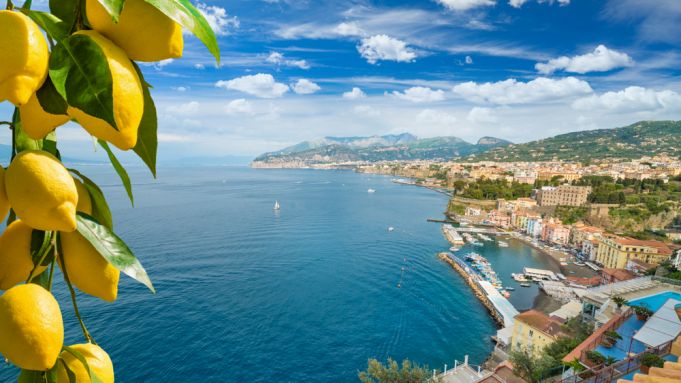Located near the Amalfi Coast, Sorrento is a must-visit destination for tourists who want to immerse themselves in the Southern Mediterranean lifestyle.
Sorrento is a small town with a population of 16,000, but its residents are warm, welcoming, and passionate about their culture.A short train ride from Naples and Pompeii, Sorrento is a picturesque escape from busy city life. Known for dazzling waters, gorgeous greenery, and of course, artisan crafted limoncello, Sorrento is the stuff of tourist dreams.
What is the history of Sorrento?
Many believe the name Sorrento comes from the myth of the Sirens. Legend has it that Sorrento was the home of the mythical Sirens that lured sailors to their deaths with their irresistible voices.Though the Sirens seem to be gone from the town, something about Sorrento calls out to travelers near and far, pulling them to its rocky coast and serene shores--as it has for thousands of years.
Under the Roman Empire, Sorrento was a vacation hotspot for elites. In the 1800s, Sorrento was a stop on the Grand Tour, the journey taken by wealthy international travelers to become more worldly.
Great artists such as Keats and Byron drew inspiration from the town and the culture of the Sorrentini people. Today, visitors still travel from all over the world to indulge in Sorrento’s scenery and mystic charm.
What is Sorrento known for?

Sorrento Lemons serve many purposes in Sorrentini cuisine, with one of the most popular being Sorrento Limoncello. Limoncello is a tart, sweet liquor made from lemon rinds.
Today, local Sorrento Limoncello is made using the same recipes and techniques that were developed centuries ago. It can be found in shops and market stands all over Sorrento. Lemon sorbet is another popular and delicious use of Sorrento Lemons.
Sorrento’s lesser known claim-to-fame is intarsia, or marquetry, the art of wood inlay. Intarsia is a meticulous, delicate style of woodworking that produces detailed mosaics and images inlaid onto boxes, doors, furniture, and other wooden surfaces.
Intarsia can be seen around the town, such as on the door of the historic Duomo dei San Filippo e Giacomo. For visitors interested in learning more about Intarsia, the Museo Bottega della Tarsia Lignea is a museum dedicated to the craft.
What is there to do in Sorrento?

One of the best ways to get to know Sorrento is by giving yourself a walking tour. Walk along the coast, and take time to stop along the many viewing points, grabbing a cup of fresh lemon sorbet as necessary.
Corso Italia is the main pedestrian street in Sorrento, and it’s a great spot to people-watch and shop. Here, visitors will find restaurants, cafes, gelaterias, and souvenir shops.
Villa Comunale is a nearby public garden that offers a serene view of Mount Vesuvius, the Bay of Naples, and the Marina Piccola port below. Make a stop at I Giardini di Cataldo, a traditional lemon grove, to see how Sorrento Lemons are farmed in Sorrento.
Stop for a coffee in Piazza Tasso, the lively central piazza in Sorrento, named after the Sorrentini poet Torquato Tasso.
Il Vallone dei Mulini is an ancient mill not far from Piazza Tasso that remains impressively intact. While visitors cannot enter the mill, they can look down on it from the road above.
When you get a craving for limoncello, walk to Limonoro, a limoncello shop that combines the tradition of limoncello-making with a passion for Sorrentino culture. Play your cards right and you might just get a free sample!
For scenic swimming, take a bus to the Bagni della Regina Giovanna, a natural pool surrounded by ancient Roman ruins.
Sorrento is also a great hopping-off point for exploring the rest of the Amalfi Coast.
It’s only a short bus ride from Positano, and a 30-minute ferry ride from Capri. Many tourists use it as a way to see Capri without staying overnight on the pricey island.
What’s the best time of year to visit Sorrento?
Sorrento is a perfect destination for spring and early summer vacations because the sea breeze offers a nice escape from hotter regions in Italy.Also read:
A guide to Ponza Island in Italy
In late summer, around July and August, Sorrento can experience days of unbearable heat and harsh sun. During this time, it’s best to plan for long days by the water and lots of lemon sorbet.
For those who prefer to travel in winter, Sorrento is a must-visit destination for its Christmas traditions. Starting in late November, Sorrento goes all out to celebrate the Christmas holidays, decorating trees, lamp posts, and streets with dazzling lights.
December is jam-packed with Christmas themed events, such as markets, concerts, and performances. On New Year’s Eve, there is a public party held in Piazza Tasso.
How can I get to Sorrento?
Though Sorrento doesn’t have an airport, the town can easily be reached from nearby cities in Italy.Buses run from most nearby cities, but traveling by train is often the fastest, cheapest option. From Naples, take the Circumvesuviana train to Sorrento. The ticket is less than 5 euro and lasts around one hour.
From Rome, take a train from the Roma Termini station to the Sorrento station. The trip lasts between two and four hours, and may include a transfer in Naples. Prices vary. Trains also run from Pompeii to Naples.
Sorrento can also be reached by ferry from Capri, Ischia, Amalfi, Positano and Naples.
General Info
View on Map
A guide to Sorrento
80067 Sorrento, Metropolitan City of Naples, Italy


















